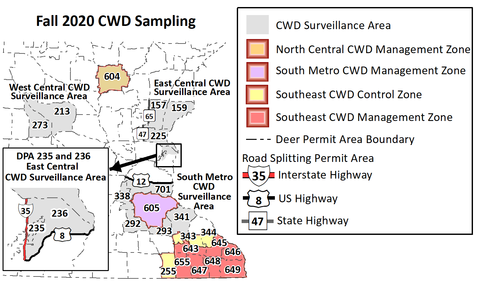It is important for all hunters to be educated and knowledgeable about chronic wasting disease (CWD). Hunters' actions play an important role in reducing the spread of CWD in Minnesota as well as providing safe, healthy food for themselves and their families. The Centers for Disease Control and Prevention (CDC) recommend that people do not consume meat from animals known to be infected with CWD. By keeping the following four areas in mind, you can do your part in combating CWD in Minnesota.
- Managing Your Deer Carcass
- Avoiding Lymph Nodes When Processing Your Deer
- Submitting Samples for CWD Testing
- Decontaminating Tools and Surfaces
Movement and management of your harvested deer is regulated by the Minnesota Department of Natural Resources. Regulations vary depending on which zone you have harvested your deer. Detailed information can be found on the DNR website: Deer carcass import and movement restrictions
Check out the DNR's YouTube videos for detailed guides:
When processing your deer, it is important to identify and remove lymph nodes from the meat that you will eat. Lymph nodes accumulate pathogens including viruses, bacteria, and prions, the disease causing agent of CWD.
A useful overview video comes from Dr. Grant Woods: How to Easily Process Your Own Deer Meat. The video highlights some of the lymph nodes you will encounter at segments beginning at 3:41 and 7:18.
Testing of samples within the CWD Zones is managed by the Minnesota Department of Natural Resources. The DNR also provides self-service chronic wasting disease sampling stations
Hunters who wish to have their deer tested for CWD outside of the CWD Zones can submit samples to the University of Minnesota Veterinary Diagnostic Lab (VDL) by collecting lymph nodes. Please Note: It is critical for test accuracy that the proper lymph node be submitted. Read more on the VDL website or see the DNR video for a demonstration of lymph node collection.
- Chronic wasting disease testing submission | VDL
- CWD sampling demonstration for hunters (video) | MN DNR
Whether you hunt in a CWD Zone or not, you may want to know the best option for cleaning your deer processing tools and surfaces. New research has demonstrated that household bleach is effective in destroying CWD prions on stainless steel.
Key facts about bleach for stainless steel decontamination:
- Clean your tools and surfaces with a one part household bleach to one part water mixture with 5 minutes of contact time. Then thoroughly rinse with water.
- Other materials such as wood and plastic can also be cleaned with the bleach mixture, but the process may not be as effective on these porous materials.
- Bleach cannot penetrate into tissues to destroy CWD prions. Remove tissue from your tools and surfaces and appropriately dispose of those tissues before cleaning.
- Always take care to protect yourself by wearing gloves, working in a well-ventilated space, and avoiding splashes to your eyes.
Learn more about using bleach to clean stainless steel from researcher Dr. Brant Race on the Sportsmen's Nation podcast: The Huntavore - Deactivation of CWD with Bleach
Williams K, Hughson AG, Chesebro B, Race B (2019). Inactivation of chronic wasting disease prions using sodium hypochlorite. PLoS ONE 14(10): e0223659. https://doi.org/10.1371/journal.pone.0223659
